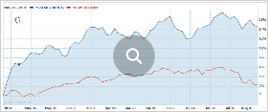Indian Railway Finance Corporation
Indian Railway Finance Corporation is coming out with a 100% book building; initial public offering (IPO) of 1,782,069,000 shares of Rs 10 each in a price band Rs 25-26 per equity share.
Not more than 50% of the issue will be allocated to Qualified Institutional Buyers (QIBs), including 5% to the mutual funds. Further, not less than 15% of the issue will be available for the non-institutional bidders and the remaining 35% for the retail investors.
The issue will open for subscription on January 18, 2021 and will close on January 20, 2021.
The shares will be listed on BSE as well as NSE.
The face value of the share is Rs 10 and is priced 2.50 times of its face value on the lower side and 2.60 times on the higher side.
Book running lead managers to the issue are DAM Capital Advisors, HSBC Securities and Capital Markets (India), ICICI Securities and SBI Capital Markets.
Compliance Officer for the issue is Vijay Babulal Shirode.
Profile of the company
The company is wholly-owned by the Government of India acting through the MoR. It is registered with the Reserve Bank of India as a NBFC (Systematically Important) and is classified under the category of an “Infrastructure Finance Company” under Section 45-IA of the Reserve Bank of India Act, 1934. It was notified as a “Public Financial Institution” under the Companies Act, 1956 through a notification dated October 8, 1993 issued by the Ministry of Corporate Affairs.
The company is the dedicated market borrowing arm of the Indian Railways. Its primary business is financing the acquisition of rolling stock assets, which includes both powered and unpowered vehicles, for example locomotives, coaches, wagons, trucks, flats, electric multiple units, containers, cranes, trollies of all kinds and other items of rolling stock components as enumerated in the Standard Lease Agreement (collectively, “Rolling Stock Assets”), leasing of railway infrastructure assets and national projects of the Government of India (collectively, “Project Assets”) and lending to other entities under the Ministry of Railways, Government of India (“MoR”). The MoR is responsible for the procurement of Rolling Stock Assets and for the improvement, expansion and maintenance of Project Assets.
The company is responsible for raising the finance necessary for such activities. Over the last three decades, it has played a significant role in supporting the capacity enhancement of the Indian Railways by financing a proportion of its annual plan outlay. The company follows a financial leasing model for financing the Rolling Stock Assets. The period of lease with respect to Rolling Stock Assets is typically 30 years comprising a primary period of 15 years followed by a secondary period of 15 years, unless otherwise revised by mutual consent. In terms of the leasing arrangements, the principal amount pertaining to the leased assets is effectively payable during the primary 15 years lease period, along with the weighted average cost of incremental borrowing and a margin determined by the MOR in consultation with it at the end of each Fiscal.
Proceed is being used for:
Industry overview
The Indian Railways is a departmental undertaking of the GoI, which owns and operates India’s rail transport, through the Ministry of Railways, GoI (MoR). The Indian Railways is the largest rail network in Asia, running approximately 13,523 passenger trains every day in Fiscal 2019 to transport approximately 23.12 million passengers per day in Fiscal 2019. As of March 31, 2019, the total running track kilometres (total all gauges) was 95,981 kilometres. Further, the total freight carried per day (including non-revenue) was 3.36 million tonnes in Fiscal 2019. As of March 31, 2019, the Indian Railways had 1.23 million regular employees. Indian Railways’ revenue increased from approximately Rs 1,787.25 billion in Fiscal 2018 to Rs 1,899.07 billion in Fiscal 2019. The Indian Railways has deployed 12,147 locomotives, 67,597 passenger service vehicles, 289,185 wagons and 6,406 other coaching vehicles as of March 31, 2019. (Source: Indian Railways - Year Book 2018-19, Ministry of Railways) There were 7,318 (revised) and 7,321 railway stations in India as of March 31, 2018 and as of March 31, 2019, respectively.
While the Indian Railways network is large, a significant proportion of the infrastructure was built during the British era. The British made significant investments in building the railway infrastructure to facilitate fast movement of goods and troops. Post-Independence, the network growth of the Indian Railways was constrained due to lower investments. The Indian Railways has been facing certain challenges such as overstretched infrastructure, with approximately 60% of the routes being more than 100% utilized and inadequate carrying capacity leading to decreasing modal share in freight and substantial unmet passenger demand. Further, due to low passenger fares, passenger trains utilized two-third of the capacity and generated one-third of revenues, whereas high freight traffic lead to railway freight being out priced in the market. Hence, it was identified to increase investment in the Indian Railways as a top priority area.
The capital expenditure plan from Fiscal 2016 to Fiscal 2020 differs from the previous investment plans by focussing on improving freight carrying capacity through capacity augmentation to achieve network decongestion, which will be done by enhancing outlay for doubling third and fourth line projects and through connectivity to logistic park. Further, this capital expenditure plan focuses on improving competitiveness of the Indian Railways through cost optimisation through electrification and improving customer experience by increasing outlay for safety, station redevelopment and passenger amenities. In addition, as a part of the investment reform agenda for the Indian Railways, the Indian Railways is setting up various joint ventures with State governments to ensure faster development of rail infrastructure.
Pros and strengths
Strategic role in financing growth of Indian Railways: The company was incorporated as the dedicated market borrowing arm for the Indian Railways and have played a strategic role in financing the operations of the Indian Railways. In Fiscal 2020, it financed Rs 713.92 billion accounting for 48.22% of the actual capital expenditure of the Indian Railways. In Fiscals 2018, 2019, 2020, and in the six months ended September 30, 2020, it financed Rolling Stock Assets worth Rs 186,698.60 million, Rs 240,550.85 million, Rs 335,441.09 million and Rs 108,163.84 million, respectively. In addition to financing of Rolling Stock Assets, it has also financed Project Assets aggregating to Rs 339,400.00 million and Rs 75,000.00 million in Fiscal 2020 and the six months ended September 30, 2020, respectively.
Consistent financial performance and cost plus model: The company has demonstrated consistent growth in terms of funding and profitability. Its total revenue from operations increased by 19.33% from Rs 92,078.39 million in Fiscal 2018 to Rs 109,873.55 million in Fiscal 2019 and by 22.15% to Rs 134,210.90 million in Fiscal 2020, and was Rs 73,848.29 million in the six months ended September 30, 2020. In Fiscals 2018, 2019 and 2020, and the six months ended September 30, 2020, its profit for the period was Rs 20,014.60 million, Rs 21,399.33 million, Rs 31,920.96 million and Rs 18,868.41 million, respectively. The company’s total outstanding borrowings increased by 29.80% from Rs 1,340,055.28 million as of March 31, 2018 to Rs 1,739,326.75 million as of March 31, 2019 and by 25.79% to Rs 2,343,767.21 million as of March 31, 2020 and was Rs 2,453,493.18 million as of September 30, 2020.
Low risk business model: The company’s relationship with the MoR enables it to maintain a low risk profile. Typically, the expenses incurred by it with respect to any foreign currency hedging costs and/ or losses (and gains, if any) as well as any hedging costs for interest rate fluctuations are built into the weighted average cost of incremental borrowing. This enables it to earn a margin, as determined by the MoR in consultation with it at the end of each Fiscal, over the life of the lease. Risks relating to damage to Rolling Stock Assets as a result of natural calamities and accidents are also passed on to the MoR. Further, the MoR is required to indemnify it at all times from and against any loss or seizure of the Rolling Stock Assets under distress, execution or other legal process.
Strong asset-liability management: In addition to traditional cash flow management techniques, the company manages its cash flows through an active asset and liability management strategy. Its asset-liability management model is structured in a manner which ensures that it has minimum asset-liability mismatches. It borrows on a long-term basis to align with the long-term tenure of the assets funded by it. Such an approach of matching the tenure of the company’s advances with its borrowings allows it to manage its liquidity better and meet the growing demands of the Indian Railways. To ensure that it always have sufficient funds to meet its commitments, the company maintains satisfactory levels of liquidity to ensure availability of funds at any time to meet operational and statutory requirements.
Risks and concerns
Significant amount of revenue comes from the Indian Railway: The company is the dedicated market borrowing arm of the Indian Railways. The vast majority of its revenue is generated from leasing Rolling Stock Assets to the Indian Railways. Lease income, interest on loans and pre commencement lease interest income together represented 99.75% and 99.87% of its total revenue from operations in Fiscal 2020 and in the six months ended September 30, 2020, respectively. Its business and revenues are substantially dependent on the policies of the MoR and operations of the Indian Railways. Any change that might affect the MoR’s ability and willingness to meet its contractual obligations under the Standard Lease Agreement entered into with it will have an adverse impact on its financial position of its Company. It does not have any control over the GoI and its related entities, including, the MoR, or its policies and any adverse changes in the policies of the GoI may have an adverse impact on the company’s business, results of operations and financial condition.
Inability to maintain Liquidity Coverage Ratio: The RBI has introduced the ‘Liquidity Management Framework’ which inter-alia mandates all the deposit accepting NBFCs irrespective of their asset size and non-deposit accepting systematically important NBFCs with asset size of Rs 100 billion and above, to maintain a liquidity buffer in the form of LCR representing high liquid assets from December 1, 2020. In terms of RBI notification titled “Liquidity Risk Management Framework for Non-Banking Financial Companies and Core Investment Companies” dated November 4, 2019, such NBFCs are initially required to maintain a minimum LCR at 50% of the net cash flows over the next 30 calendar days which will then progressively increase to 100% by December 1, 2024. In the event, it is unable to comply with the aforesaid requirements it may be subject to penalties that will adversely impact its business, financial condition and results of operations.
Competition from financial and other institutions: The company faces competition from financial and other institutions aiming to raise funds from the market. The market for raising funds is competitive and its ability to obtain funds on acceptable terms, or at all, will depend on various factors including its ability to maintain its credit ratings. In addition, since it is a non-deposit accepting NBFC, it may have restricted access to funds in comparison to banks and deposit taking NBFCs. Its primary competitors are public sector undertakings, public sector banks, financial institutions and other NBFCs. In the event that the terms and conditions of the debt instruments offered by such institutions are more attractive than those offered by it, it may not be able to raise debt from the market to the extent and on terms and conditions beneficial to it. If it is unable to raise such debt, it would lead to an increase in its cost of borrowings and thus, potentially affect its financial condition and results of operations.
Business is dependent on the growth of Indian railway sector: The Indian Railways faces significant competition in the transport sector from other means of transportation such as transport by road, sea and air. While the Indian Railways continuously looks to augment its infrastructure and undertake other necessary improvements to the railway network, competition in freight traffic from the road sector is likely to intensify further, as present projects for upgrading road networks are completed. The Indian Railways’ vulnerability to competition from other means of transportation could increase if cross-subsidies between freight and passenger fares remain at the current high levels, particularly when the road network is improving, and oil pipelines are being built. Therefore, any slowdown in the growth of the Indian railways sector and changes in the policies of, or in the level of direct or indirect support to it provided by the GoI in these or other any areas could have a material adverse effect on its business, financial condition and results of operations.
Outlook
Indian Railway Finance Corporation (IRFC) is a public-sector enterprise that is wholly-owned by the Government of India. IRFC is primarily engaged in financing the acquisition of rolling stock assets, leasing of railway infrastructure assets, and lending to entities under the Ministry of Railways (MoR). Being the borrowing arm of Indian Railways, IRFC is responsible to raise funds for MoR that is required to procure rolling stock assets (wagons, trucks, electric multiple units, locomotives, coaches), its improvement, expansion, and assets management. On the concern side, the company derives significant amount of its revenue from operations from the Indian Railways. A loss of or reduction in business from the Indian Railways, any direct borrowing by the Indian Railways or introduction of any new avenues of funding by the Ministry of Railways, Government of India could have an adverse effect on its business.
The issue has been offered in a price band of Rs 25-26 per equity share. The aggregate size of the offer is around Rs 4455.17 crore to Rs 4633.38 crore based on lower and upper price band respectively. Minimum application is to be made for 575 shares and in multiples thereon, thereafter. On performance front, Total revenue from operations increased by 12.29% from Rs 65,747.68 million in the six months ended September 30, 2019 to Rs 73,831.20 million in the six months ended September 30, 2020 primarily due to an increase in lease income and interest income. The company recorded a profit for the period of Rs 18,868.41 million in the six months ended September 30, 2020 compared to Rs 16,303.93 million in the six months ended September 30, 2019.
The company has historically issued, through public issues of tax-free bonds and private placements of tax-free and taxable bonds with innovative structures, securitized receivables from the MoR and availed external commercial borrowings including syndicated loans, bonds and notes. It continues to diversify its borrowing portfolio through a range of financing instruments and identifying new markets and investors, including through issuance of ‘green bonds’ and ‘medium term notes’. Moreover, the company is planning to diversify its financing portfolio to include forward and backward linkages for railways sector. Such core infrastructure focused businesses will benefit from the significant investment proposed by the GoI and various State governments as well as by the private sector.































